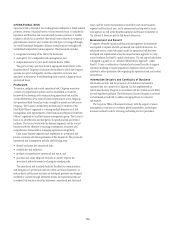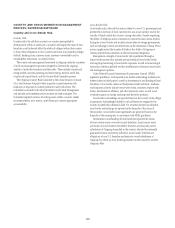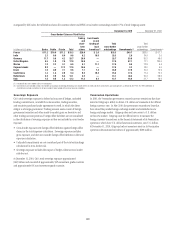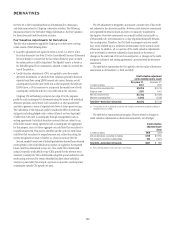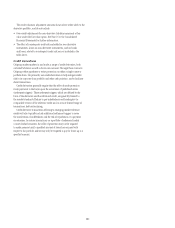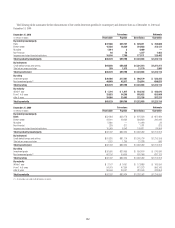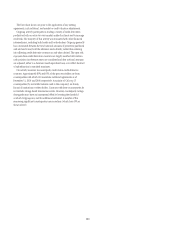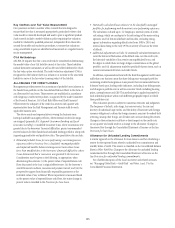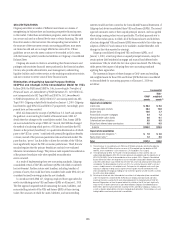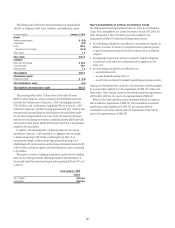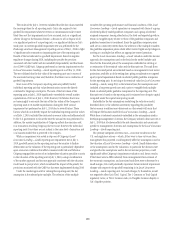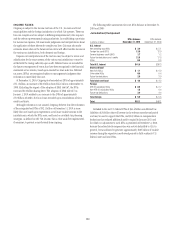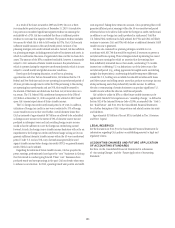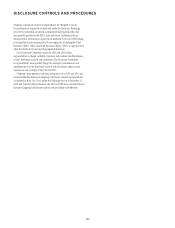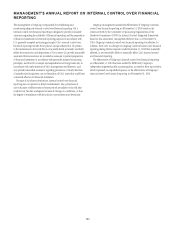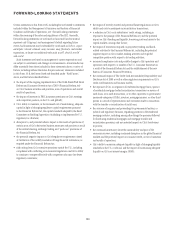Citibank 2010 Annual Report Download - page 138
Download and view the complete annual report
Please find page 138 of the 2010 Citibank annual report below. You can navigate through the pages in the report by either clicking on the pages listed below, or by using the keyword search tool below to find specific information within the annual report.
136
SECURITIZATIONS
Citigroup securitizes a number of different asset classes as a means of
strengthening its balance sheet and accessing competitive financing rates
in the market. Under these securitization programs, assets are transferred
into a trust and used as collateral by the trust to obtain financing. The cash
flows from assets in the trust service the corresponding trust securities. If
the structure of the trust meets certain accounting guidelines, trust assets
are treated as sold and are no longer reflected as assets of Citi. If these
guidelines are not met, the assets continue to be recorded as Citi’s assets,
with the financing activity recorded as liabilities on Citigroup’s Consolidated
Balance Sheet.
Citigroup also assists its clients in securitizing their financial assets and
packages and securitizes financial assets purchased in the financial markets.
Citi may also provide administrative, asset management, underwriting,
liquidity facilities and/or other services to the resulting securitization entities
and may continue to service some of these financial assets.
Elimination of Qualifying Special Purpose Entities
(QSPEs) and Changes in the Consolidation Model for VIEs
In June 2009, the FASB issued SFAS No. 166, Accounting for Transfers of
Financial Assets, an amendment of FASB Statement No. 140 (SFAS 166,
now incorporated into ASC Topic 860) and SFAS No. 167, Amendments
to FASB Interpretation No. 46(R) (SFAS 167, now incorporated into ASC
Topic 810). Citigroup adopted both standards on January 1, 2010. Citigroup
has elected to apply SFAS 166 and SFAS 167 prospectively. Accordingly, prior
periods have not been restated.
SFAS 166 eliminates the concept of QSPEs from U.S. GAAP and amends
the guidance on accounting for tranfers of financial assets. SFAS 167
details three key changes to the consolidation model. First, former QSPEs
are now included in the scope of SFAS 167. Second, the FASB has changed
the method of analyzing which party to a VIE should consolidate the VIE
(known as the primary beneficiary) to a qualitative determination of which
party to the VIE has “power,” combined with potentially significant benefits
or losses, instead of the previous quantitative risks and rewards model. The
party that has “power” has the ability to direct the activities of the VIE that
most significantly impact the VIE’s economic performance. Third, the new
standard requires that the primary beneficiary analysis be re-evaluated
whenever circumstances change. The previous rules required reconsideration
of the primary beneficiary only when specified reconsideration
events occurred.
As a result of implementing these new accounting standards, Citigroup
consolidated certain of the VIEs and former QSPEs with which it currently
has involvement. Further, certain asset transfers, including transfers of
portions of assets, that would have been considered sales under SFAS 140, are
considered secured borrowings under the new standards.
In accordance with SFAS 167, Citigroup employed three approaches for
newly consolidating certain VIEs and former QSPEs as of January 1, 2010.
The first approach required initially measuring the assets, liabilities, and
noncontrolling interests of the VIEs and former QSPEs at their carrying
values (the amounts at which the assets, liabilities, and noncontrolling
interests would have been carried in the Consolidated Financial Statements, if
Citigroup had always consolidated these VIEs and former QSPEs). The second
approach measures assets at their unpaid principal amount, and was applied
where using carrying values was not practicable. The third approach was to
elect the fair value option, in which all of the financial assets and liabilities
of certain designated VIEs and former QSPEs were recorded at fair value upon
adoption of SFAS 167 and continue to be marked to market thereafter, with
changes in fair value reported in earnings.
Citigroup consolidated all required VIEs and former QSPEs, as of
January 1, 2010, at carrying values or unpaid principal amounts, except for
certain private label residential mortgage and mutual fund deferred sales
commissions VIEs, for which the fair value option was elected. The following
tables present the impact of adopting these new accounting standards
applying these approaches.
The incremental impact of these changes on GAAP assets and resulting
risk-weighted assets for those VIEs and former QSPEs that were consolidated
or deconsolidated for accounting purposes as of January 1, 2010 was
as follows:
Incremental
In billions of dollars
GAAP
assets
Risk-
weighted
assets (1)
Impact of consolidation
Credit cards $ 86.3 $ 0.8
Commercial paper conduits 28.3 13.0
Student loans 13.6 3.7
Private label consumer mortgages 4.4 1.3
Municipal tender option bonds 0.6 0.1
Collateralized loan obligations 0.5 0.5
Mutual fund deferred sales commissions 0.5 0.5
Subtotal $134.2 $19.9
Impact of deconsolidation
Collateralized debt obligations (2) $ 1.9 $ 3.6
Equity-linked notes (3) 1.2 0.5
Total $137.3 $24.0
(1) The net increase in risk-weighted assets (RWA) was $10 billion, principally reflecting the deduction
from gross RWA of $13 billion of loan loss reserves (LLR) recognized from the adoption of SFAS
166/167, which exceeded the 1.25% limitation on LLRs includable in Tier 2 Capital.
(2) The implementation of SFAS 167 resulted in the deconsolidation of certain synthetic and cash
collateralized debt obligation (CDO) VIEs that were previously consolidated under the requirements of
ASC 810 (FIN 46(R)). Due to the deconsolidation of these synthetic CDOs, Citigroup’s Consolidated
Balance Sheet now reflects the recognition of current receivables and payables related to purchased
and written credit default swaps entered into with these VIEs, which had previously been eliminated in
consolidation. The deconsolidation of certain cash CDOs has a minimal impact on GAAP assets, but
causes a sizable increase in risk-weighted assets. The impact on risk-weighted assets results from
replacing, in Citigroup’s trading account, largely investment grade securities owned by these VIEs
when consolidated, with Citigroup’s holdings of non-investment grade or unrated securities issued by
these VIEs when deconsolidated.
(3) Certain equity-linked note client intermediation transactions that had previously been consolidated
under the requirements of ASC 810 (FIN 46 (R)) because Citigroup had repurchased and held a
majority of the notes issued by the VIE were deconsolidated with the implementation of SFAS 167,
because Citigroup does not have the power to direct the activities of the VIE that most significantly
impact the VIE’s economic performance. Upon deconsolidation, Citigroup’s Consolidated Balance
Sheet reflects both the equity-linked notes issued by the VIEs and held by Citigroup as trading assets,
as well as related trading liabilities in the form of prepaid equity derivatives. These trading assets and
trading liabilities were formerly eliminated in consolidation.


